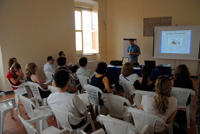How to design a participatory process for a research institute on a controversial issue?
Contact:
Pierre-Benoit JOLY, INRA/TSV, France, joly@ivry.inra.fr
This case study trains you to design a participatory process for a research institute on a controversial issue. The case study is located in France and deals with the controversy on GMO’s.
Short description of the case

The participants have to address the problem of a research institution aiming at organising a participatory process in order to deal with a controversial issue. They are introduced to the context of the case and then have to perform a set of tasks:
- set the scene
- propose a procedure of consultation and/or participation of publics/ stakeholders/ interested parties
- explain the rationale of this choice its risks and the critical points

This case is developed on the basis of an initiative of the French National Institute for Agronomic Research (INRA) on GM Vine Field Trials in 2001-2002.
Training objectives
The participants learn :
- to take into account the importance of issue framing in the design of a participatory process
- to consider the strategic and political implications of public participation
- to integrate these dimensions in the design of a participatory initiative (choice of method, critical implementation points, etc.)
This case is specifically designed for researchers (or managers of research institutions), members of NGO’s, and companies involved in research activities. It will also be of high interest for those who have a general interest for citizen participation in science and technology.
Training method
Participants work in small groups on a problem solving activity designed to simulate « real life » situations. With the assistance of trainers / CIPAST members they have to perform some key tasks which are described above.
This case requires 5-7 hours: 0,5-1 hour of introduction to the case; 3-4 hours of collective work in small group; 1-2 hours of presentation and debriefing.
Previous knowledge required
For this case study to be really efficient, participants have to good understanding of participatory procedures. See for instance the CIPAST methodology posters (chapter 4.1 ).
Guideline on how to work with the case study
1. Read: the ID Card GM Vine [81 kb, pdf]
A. INTRODUCTION
2. Read A1: GM Vine Working Material. [322.3 kb, pdf]
3. Read A2: Democratizing experiment? An abridged version of the article by Bonneuil, Joly and Marris. [343.5 kb, pdf]
4. Read the CIPAST methodology posters. (chapter 4.1 )
B. FRAMING
5. Split into groups. Discuss the case study. Answer the following questions:
- What is the problem?
- Who is involved?
- What role can INRA play?
6. Present the answers in plenary.
C. DESIGN A METHOD
7. Split into groups. Answer the following question: What method is most suitable for this case study?
8. Present the chosen methodology in plenary. Explain the rationale of this choice, its risks and the critical points.
D. DISCUSSION
9. Discuss the results.
10. Read D1: experience report GM Vine. [505 kb, pdf]
11. Read D2: Article on GM Vine. [700.6 kb, pdf]
12. Discussion on the actual GM Vine case. Moderators can also report on the actual case.
E. EVALUATION
13. Evaluate this case study. Please fill in E1: the handout participants impressions: positive and negative about this case workshop [77.5 kb, pdf]
F. SCHEDULE
(based on Procida workshop):
| Start | End | Activity |
|---|---|---|
| 9:00 | 9.15 | Introductory Powerpoint presentation 1 |
| 9.15 | 9.30 | Questions and clarifications |
| 9:30 | Split into groups | |
| 9.40 | 10.30 | Set the scene |
| 10.30 | 11.00 | Plenary reporting |
| 11.00 | 11.30 | Break |
| 11.30 | 13.00 | Choose a participative process in groups |
| 13.00 | 14.30 | Lunch |
| 14.30 | 15.30 | Choose a participative process in groups. Argument on the reason for this choice, make risks and critical points explicit |
| 15.30 | 16.00 | Present chosen methodologies in plenary |
| 16.00 | 16.30 | Discussion and evaluation |
1The Power Point Presentation of this case study is partially in French and very hard to understand without the explanation of Pierre-Benoît Joly. The PPP is available, but the working material gives enough introductory information for this case study.


